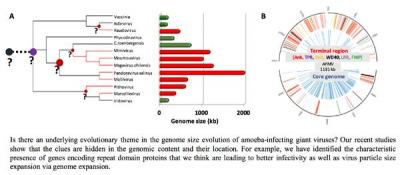
With a particle size of 1 micro meter and grnome size of more than 2 Mbp, which is bigger than many bacteria, giant viruses are changing the way we think about viruses and concept of obligate parasitism.Not too long ago, scientific community believed that viruses cannot be much bigger than 200 nm and in the process missed them completely until an accidental discovery of a giant virus (microbe mimicking virus or mimivirus) in 2003. The rest is history.If one looks at their enigmatic genetic makeup, their abundance and prevalence, it appears
that the arrival of giant viruses is an important landmark in the evolutionary history of life itself. The origin and evolution of giant viruses, how and why they got so big and complex? Where
do they belong in the tree of life? Whether they belong there at all, are matters of continued debate. Tracing the natural history of some of the unique genes indicate that giant viruses of
mimivirus-lineage could have emerged well before the cellular organisms. Today, we know that these giant viruses are not just freaks of nature. Their close relatives are present in very large numbers,mainly in aquatic environments. Some of them are even thought to be human pathogens. We have isolated and sequenced several giant viruses from Mumbai. Our metagenomics study further showed that these viruses are present in all environments including drinking water. Since most of these large dsDNA viruses seem to be involved in controlling the growth of planktons and micro-algae in the sea, they could have played major roles in the early evolutionary processes as well as shaping the earth’s environment and temperatures. Our research has indicated that these large viruses resemble bacteria in many ways. For example, genome packaging, a critical step in the assembly of viruses, is carried out by a mechanism that is very similar to the one used by bacteria for genome separation into daughter cells during its replication. Giant viruses have followed a complex evolutionary path wrought with a series of gene acquisitions, deletions, particle size expansion and contraction, mainly driven by environmental stressors as another study from the lab has shown recently (refer figure). We need to understand their biology thoroughly to understand their evolutionary origins.
Prof. Kiran Kondabagil
